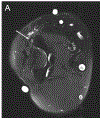Advances in Imaging of Compressive Neuropathies
- PMID: 38972677
- PMCID: PMC12145196
- DOI: 10.1016/j.hcl.2024.04.003
Advances in Imaging of Compressive Neuropathies
Abstract
Ultrasound and magnetic resonance neurography are useful modalities to aid in the assessment of compressive neuropathies, although they are still limited in their resolution of nerve microstructure and their capacity to monitor postoperative nerve recovery. Optical coherence tomography, a preclinical imaging modality, is promising in its ability to better identify structural and potential physiologic changes to peripheral nerves, but requires additional testing and research prior to widespread clinical implementation. Further advances in nerve imaging may elucidate the ability to visualize the zone of nerve injury intraoperatively, monitor the progression of nerve regeneration, and localize problems during nerve recovery.
Keywords: Compressive neuropathy; Magnetic resonance neurography; Nerve imaging; Peripheral nerve; Ultrasound.
Copyright © 2024 Elsevier Inc. All rights reserved.
Conflict of interest statement
Disclosure Dr C.J. Dy is on the Medical Advisory Board for Orthocell. He receives speakers’ fees from Johnson and Johnson/DePuy Synthes. He has research support from the National Institutes of Health and Sonex Healthcare. Dr D.M. Brogan serves as a committee chair in the American Society for Surgery of the Hand and an officer of the Missouri State Orthopedic Association. He receives royalties from Springer and is a paid consultant for Checkpoint Surgical. He has additional research funding from the National Institutes of Health, Department of Defense, United States, American Foundation for Surgery of the Hand, United States, Orthopedic Research and Education Foundation, United States,Checkpoint Surgical, and Neuraptive Therapeutics.
Figures

















References
-
- Richardson JK, Evans JE, Warner JH. Information effect on the perception of pain during electromyography. Arch Phys Med Rehabil. 1994;75(6):671–675. - PubMed
Publication types
MeSH terms
Grants and funding
LinkOut - more resources
Full Text Sources
Medical

